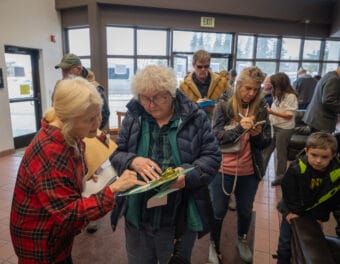
Editor’s Note: This article was partially inspired by a collaboration with Alaska Public Media, which reached out to voters across the state online and in person to find out what you want to know this election season. To learn more, see the end of the article.
Because of a federal court decision last year, the state’s failure to appeal that decision, and the Alaska Legislature’s failure to approve a new law, candidates for Alaska state Legislature and governor can accept unlimited amounts of money from individual donors.
Those donations may be unlimited, but each must be disclosed and published as public information. Donations to federal candidates — those running for U.S. House and U.S. Senate — do have limits, but they are public information, too. So are donations to third-party groups, such as unions, or groups supporting a particular ballot measure or industry.
Here’s what you need to know.
Why does it matter?
Campaign finance records — listings of who donates, how much a candidate has raised, and how much a candidate has spent — can show the strength or weakness of a political campaign, a clue to whether a candidate will win or lose.
When it comes to the U.S. House, for example, the candidate who raises the most money wins 90% of the time.
Tracking where donations come from can show whether a candidate’s support is in their own district, or if they’re receiving large amounts of money from people who don’t live in a particular place and can’t vote for that particular candidate.
Tracking who donates can reveal whether a particular corporation or industry believes a candidate is likely to support its interests. Looking at how much a person donates can show if a candidate is being backed by just a few wealthy people or if their ads are being bought with the small contributions of many people.
When to look
The Alaska Public Offices Commission, a state agency, regulates state-level races and publishes campaign finance reports on its website.
Anyone who intends to raise or spend at least $5,000 while running for state office needs to register with the commission by filing a letter of intent.
These letters are searchable and sometimes are filed a year or more before an election. They’re useful for determining who is thinking about running for office but not a guarantee: Until someone registers with the Alaska Division of Elections, they’re not an official candidate.
When someone registers, they need to disclose their campaign spending and donations at different points: the start of the calendar year, 30 days before the primary election, 7 days before the primary, 30 days before the general election and 7 days before the general election.
Any donations within 7 days of an election get special reports.
Any of these times are good ones to look at records, because they’ll have the most up-to-date information available.
For this year’s Nov. 8 general election, all candidates need to report their fundraising on Oct. 10 and Nov. 1.
Even after the election, candidates can still accept donations to pay outstanding debts or to save for their next campaign. The deadline to do that is Dec. 23, and the final election report — including everything raised and spent — is due Feb. 15, 2023.
Federal candidates report their fundraising and spending with the Federal Election Commission, and they do have a limit. Candidates can only accept $5,800 from an individual during an election cycle – $2,900 for the primary and $2,900 for the general.
Federal candidates report each quarter, plus a report before the election and a report after the election.
This year, a quarterly report is due Oct. 15, and the pre-election report is due Oct. 27. Post-election reports are due Dec. 8 and Jan. 31, 2023.
Because there was a special election for U.S. House this year, candidates needed to file some extra reports, the most recent being Sept. 15.
The FEC website is fairly user-friendly, but APOC searches are more difficult.
How to search state candidate information
When you open the APOC website, you’ll see a whole list of options. Clicking “Campaign Disclosure Reports” lets you search for specific candidates, specific donors, and even things candidates have spent their money on.
Other links — such as for “income” and “expenditures” – allow you to search all donations, regardless of candidate, or all spending, regardless of candidate.
All of the searches work roughly the same.
First, select the year you want to search. If you use the default “any year,” you may get results from prior elections that aren’t relevant anymore.
Second, select a date range, keeping in mind when candidates submit their reports. You can leave this blank, but you’ll have to look through all the reports a candidate has filed for an entire year.
If you’re just looking for the latest report, do yourself a favor and narrow it down. If you’re searching around Oct. 10, for example — because that’s when the next report is due — just search for reports filed between Sept. 10 and Oct. 10.
Next, use the drop-down menu labeled “any name” to select “candidate name.” This allows you to enter who you want to search for. Leaving it blank will show all the reports filed by every candidate for every office.
There’s another drop-down menu to the right of the candidate name, and that allows you to limit searches by the type of election — if you wanted to search for city election filings, for example — but it’s generally unnecessary.
How to read the filings
As a test, I’ve done a search for all reports filed by independent governor candidate Bill Walker between July 15 and Aug. 17. That range is big enough to include every report filed for the Aug. 16 primary election. You can see the result below.
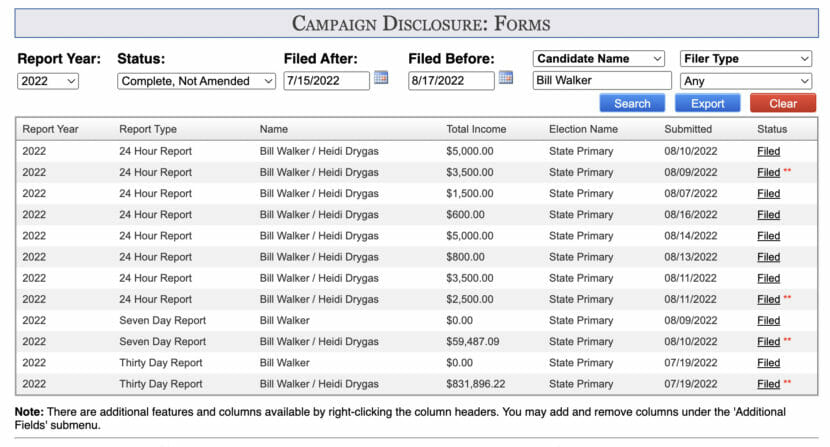
Clicking on the “filed” link at the right of each entry will bring up a copy of the report. Click on the seven-day report filed on Aug. 10 as an example.
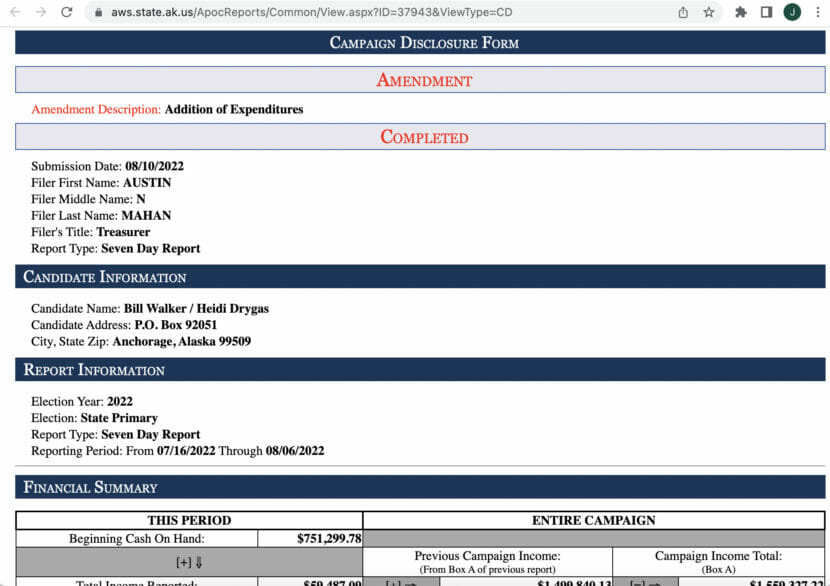
Each candidate report is broken down into roughly four parts. At the top is information that tells you who filed the report, who the candidate is, what election it’s for and what information is included in the report.
Here, for example, we can see under “report information” that this includes everything from July 16 — when they filed their 30-day report — through Aug. 6.
The part after that, called “financial summary,” shows the financial health of the candidate’s campaign.
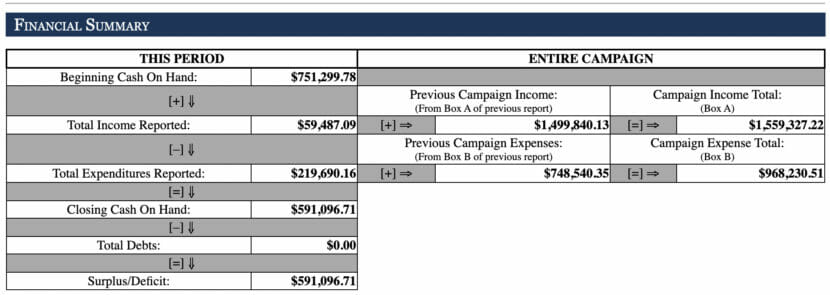
The first line, “beginning cash on hand,” tells you how much money the campaign had on July 16, the day this report begins. The second line, “total income reported,” lists how much money the candidate received in donations from July 16 through Aug. 6, the period we saw under “report information.”
The next line, expenditures, shows how much the candidate spent from July 16 through Aug. 6.
If you add cash on hand to income, then subtract expenditures, you get “closing cash on hand,” which is how much money the campaign had on Aug. 6.
If the candidate has any debts — things it’s bought but hasn’t paid for yet — those are listed on the report, and subtracting those from “closing cash on hand” gets you “surplus/deficit,” how much money they have available to spend.
Off to the right are entries for how much money the candidate has raised and spent for their entire campaign, not just the period covered in this report.
The next part of the report, “income,” lists who donated to a campaign, where they live, and how much they gave. State law requires all of this information to be collected by the campaign and published. Again, this example lists only donations between July 16 and Aug. 6; other reports will cover other periods.
The last part of the report, “expenditures,” lists all the things a candidate has bought with their donations during the period listed on the report.
If a listing in either “income” or “expenditures” is blue instead of black, it indicates that someone donated an item to a candidate — usually airline miles or airline tickets, but silent auction items or campaign signs donated by a candidate to themselves (needed if they’re recycling items from a prior campaign) show up in blue.
Other searches
If you’re looking for a specific donor or want to search for all donations to a candidate, regardless of when they were made, go to the APOC site and click “Campaign Disclosure Reports – Search Income.”
There’s a similar expenses-only search if you’re trying to figure out, say, how many candidates have spent money buying candy.
Candidates and individuals aren’t the only ones involved in elections. Groups supporting or opposing ballot measures have to follow similar reporting schedules and rules as candidates. Their filings will show up under “Campaign Disclosure Reports” if you search the name of the group. In some cases, the best way to learn that name is to look for the fine print at the bottom of a printed ad or to listen for the quickly-spoken disclosure at the end of a TV or radio ad.
These groups are limited by law, but there’s another category of political group that’s worth knowing about.
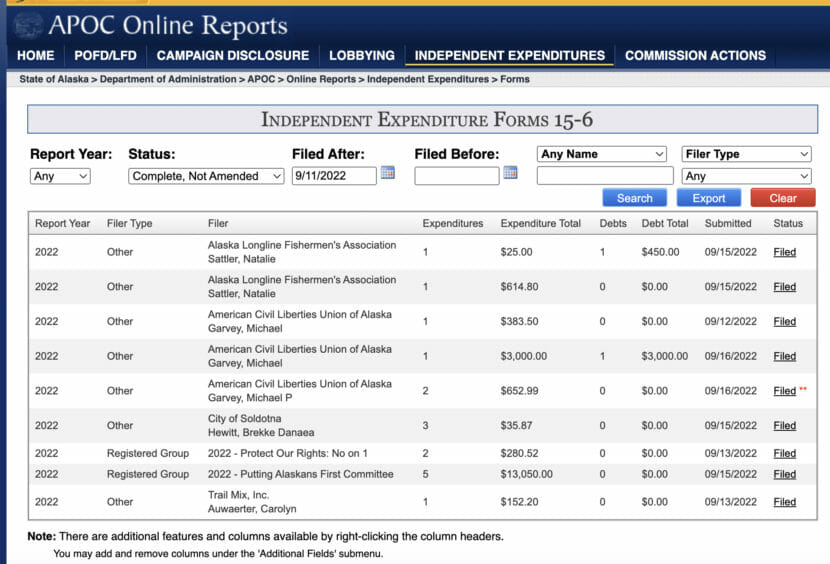
So-called “independent expenditure” groups are allowed to accept and spend unlimited amounts of money as long as they don’t coordinate directly with a candidate or campaign.
Independent expenditure groups are required to file reports within 10 days any time they collect or spend money.
To search those filings, click “independent expenditures” at the top of the APOC website. Using only a date range will reveal everything filed within a given period of time.
Find more elections coverage and voter resources at Alaska Beacon’s Election 2022 webpage and at Alaska Public Media’s Election Coverage webpage. Learn more about Alaska Public Media’s voter outreach and their collaboration with other local news organizations here. Remember – you have until Oct. 9 to register to vote or to update your voter registration. Find out how here.



